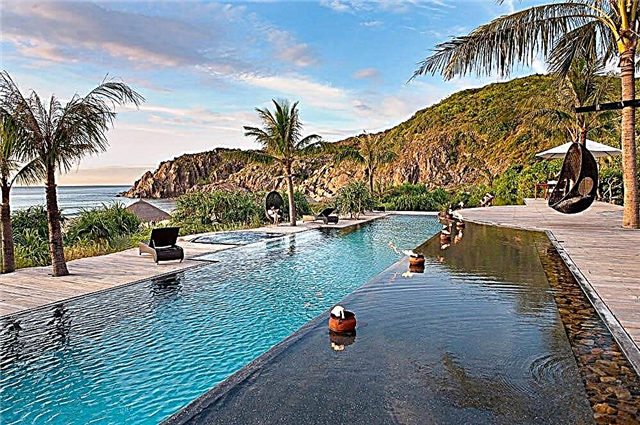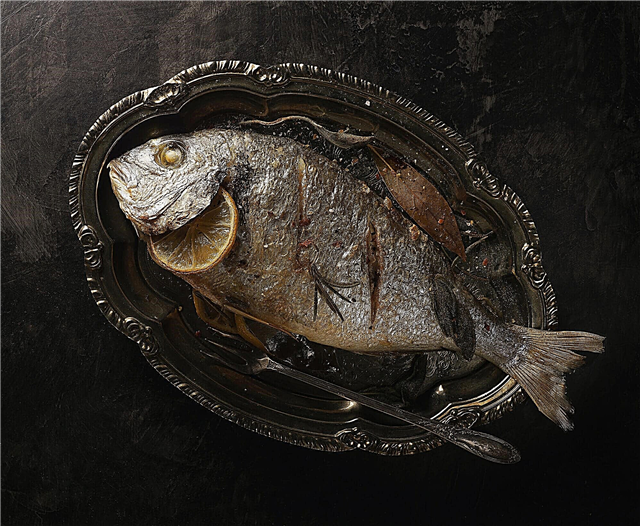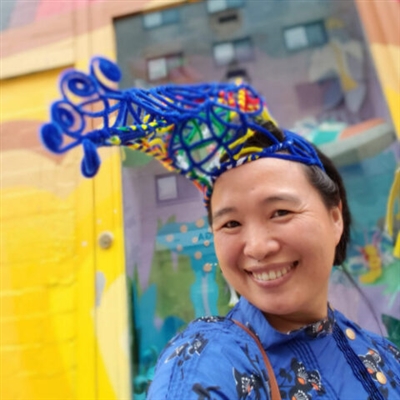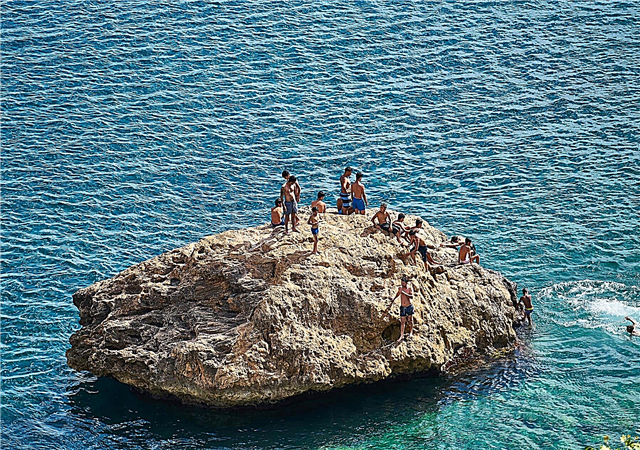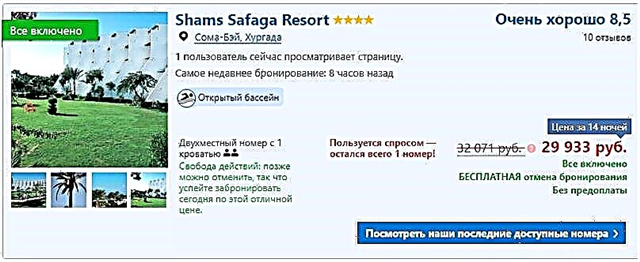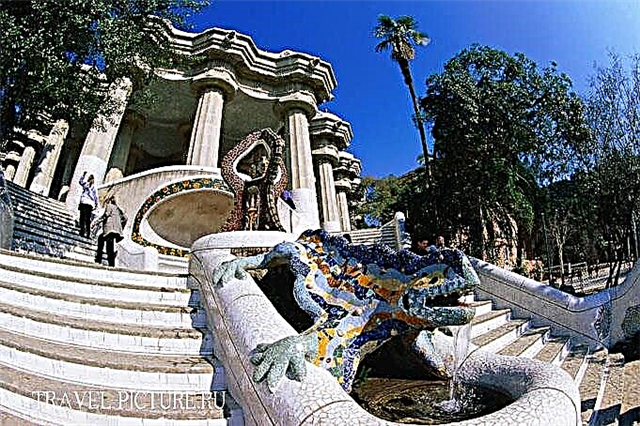What to see in Barcelona and the surrounding area on your own for 2, 3 or 5 days of relaxation for two, or maybe the whole family and children? We will consider and show all the best places to be seen with our own eyes, we will make a selection of excursions with Russian-speaking guides that most accurately open the perspective of the city and districts, we will find out the prices.
Rambla Boulevard (La Rambla)
One of the most popular attractions when traveling on your own in Spain is the Ramblas. The main tourist flow passes along this street, which starts from the Columbus monument in the Old Port. The Ramblas is a separate fascinating world among all the streets, life is in full swing on it day and night.
On the boulevard you will find artists, street dancers and actors, restaurant managers inviting to taste Spanish cuisine, many souvenir shops, flower shops and much more.

The name of the Ramblas in Arabic "Rambla”Means a mudflow of water from the mountains to the sea. This was the case in ancient times, but after the erection of the wall blocking the flow of water, everything ended and the mudflow dried up, but the wavy patterns on the tiles of the square will remind the tourist of what happened here.
While walking, you should definitely take a picture of a mosaic for yourself. Joana Miro, the opera house, the Canaletas fountain and it is worth visiting the most important phenomenon - the Boqueria market, the central entrance of which is just on the boulevard.
The famous Cathedral of the Sagrada Familia (Sagrada Familia)
What to see in Barcelona on your own from the interesting places of architecture in the first place? A unique long-term construction of all times, which tourists from all over the world come to see and visit, is the Cathedral of the Sagrada Familia. The temple has been built with the private funds of the parishioners since 1882 and is one of the creations Antoni Gaudias well as the longest construction site in the world.

In 2008, the construction of the Cathedral of the Sagrada Familia was stopped by the figures of the cultural life of Spain due to careless restoration. A statement was also made that each block in the construction of the temple requires computer and precise processing, which is an expensive and time-consuming process. The construction of the temple is promised to be completed by the end of 2026, we will wait.
The Sagrada Familia was originally planned for a construction project in the form of a Latin cross with 18 towers, but we will never see the creation as the architect Antoni Gaudi imagined.

The object is open to tourists every day, during the peak of the tourist season, there are a lot of people who want to get to the Cathedral, so people take a queue here from early morning.
Let's reveal a little secret, construction is underway inside the temple, except for scaffolding and debris, you will not see anything here. But you can still visit the history museum and climb the tower for an amazing view of the city.
- Opening hours of the Sagrada Familia from 9 am to 6 pm, the cost of one adult ticket is 14 euros, with an audio guide 20 euros. In order not to stand in line, tickets can be booked on-line on special Spanish sites.
Gothic Quarter and Cathedral
The oldest attraction in the city, near the Ramblas, is the Gothic Quarter. Here you will see centuries-old buildings, one of which is the Cathedral, built in 1420. You will plunge into the world of historical architecture, as well as visit the square and see the place where the film was filmed “Perfumer”.

The area of the Gothic Quarter in the Middle Ages was the main fish-trading area of the city, as we already told in the last article, it was simply not possible to live near this place because of the rotten fishy smell spreading over several blocks.

The Cathedral is the seat of the Bishop of Barcelona and is located, you guessed it, in the square of the Gothic Quarter.
The 15th century building is made in the Gothic style, like the entire Gothic quarter.
- The entrance fee to the Cathedral is 6 euros, the opening hours are from 8 am to 7 pm.
Outside it can be viewed for free, but it is better to go inside, the architecture of that time will simply shake you with its age-old and historical spirit.

Agbar Tower
The Agbar Tower is the city's office pride, and the building's sparkling views can be enjoyed after sunset. The Agbar Tower was opened in 2005 for office space, so it is unlikely that you should visit the inside of this building, you will not find anything interesting except its appearance here.

The construction lasted for 7 years, the design was based on such principles of the structure that the panels on the outer part of the building from the heating of the sun begin to close and the building is cool and fresh air.
The building is 143 meters high and has 5,000 LED devices that delight the eye at night. Forgot to mention that in Spanish society there are obscene nicknames about this building.
Monastery of San Miguel del Fay

One of the most unusual and beautiful sights of Spain is located in Catalonia and created by nature itself - the Monastery of San Miguel del Fay.
The monastery, located 48 kilometers from the city and far from civilization, was built in the rock by the manual labor of several people, its walls and roof are rock.
The monastery was built in the 15th century and was inhabited by only 10 monks. Nowadays, this is a wonderful monument with waterfalls, caves, rocky grottoes, lakes, and it will simply make you forget about the bustle of the city and leave bad thoughts far beyond this beautiful place.

You can get there only with a guided tour or by your own car; during the tour, you will be told amazing stories about the creation of the monastery, its traditions and way of life in those days, far from all the benefits of civilization.
- The cost of the excursion for one adult is 25 euros, it is better to check the cost with the tour operator.
Montserrat
Another great place that you can see in Barcelona on your own in 1 day of rest is located far from the city, in the center of the Catalunya park - the Montserrat Monastery.
It is visited not only by pilgrims, but also by sportsmen, hunters and lovers of extreme sensations. Having visited the top of the mountain, you will breathe in the fresh mountain air, hear the singing of a children's choir and make a wish for a healing statue of the Madonna found in a deep cave. All this awaits you during your visit, after the excursion you will have a long feeling of sadness in your soul and the desire to come back.

At the top you will be greeted by huge rounded stones of the mountain range on the slopes of which Montserrat was built, and from the mesmerizing view of the whole of Catalonia, you will be speechless, being next to the statue of the black Madonna holding a child in the hands, you will feel a surge of energy and vitality ...
But the statue of the Madonna, which you are about to see, is the original of the 12th century, the first statue of the Madonna disappeared without a trace and has not yet been found. You can feel the miraculous power and energy of the Madonna yourself, having visited the room where gifts are brought for those whom she healed.

In the monastery itself, which has been restored after destruction since 1844, there is now a museum with art objects with works by Caravaggio and Salvador Dali.
In one of the buildings of this building lives the boys' choir from 9 to 14 years old, which has been famous for its popularity since the 13th century.Tourists have a unique chance to hear golden voices every day.
Leaving here and not having visited the very top of the mountain, which is often climbed by extreme athletes, you will lose a lot. Here you can see a unique natural landscape: mountain vegetation, rounded stones that have their own names.
- You can climb to the top using the funicular. The cost of the excursion should be checked with the tour operator.
Montjuic hill
One of the most popular excursions in Barcelona is Montjuïc Hill, especially in the evening. The famous mountain in the capital of Catalonia. The height of the hill is 175 meters. The hill got its name since ancient times, when the bulk of the population was made up of Jews, who were buried here, from that time the mountain was nicknamed “the Jewish mountain”. A gorgeous view of the sea and the city opens from here, so be sure to take your camera with you.

It is worth noting the singing fountains, as almost all tourists who have a rest in Spain come to see such a stunning spectacle.
- The fountains are open from Thursday to Sunday from 7 pm to 11 am, each session of the musical performance lasts 20 minutes. We recommend that you arrive at this event prior to its opening to seize your tables and enjoy some fruit cider.

On the hill of Montjuïc is the "Spanish Village", which is a museum of architecture, which contains copies of historic buildings from different regions of Spain. Here you will see a replica of the gate from the city of Avila and many other unique buildings. Not far from the museum is the Olympic Stadium and the Sports Palace, which were built for the Olympic Games in 1992.
Park Guell (ParkGuell)
What to see in Barcelona on your own in 2 days of rest? We advise you to go to Park Guell! This place is located in the upper part of the city and is the most famous park in the world, again created by the architect Antoni Gaudi in 1914. Dyou can get to this amazing park by metro (station Lesseps).
The park is made in a fabulous style and covers an area of 15 hectares, divided into 62 plots for the construction of mansions with their own gardens. All 62 plots were planned to be sold in a very short time, but the remoteness from the city center and the area, where nothing grew, did not attract Barcelona residents, since then only 3 plots have been sold.
The first site was bought by Gaudi himself and built a house there and lived until 1925, and the house of his friend M. Trias-i-Domenech was purchased next door.
The third plot was sold to the politician and industrialist Eusebi Guell, whose idea was Park Guell. Guell's house is now a public school, and Gaudí's house is now open to you as a Gaudí museum.
The third house of the Trias y Domenech is currently the family property of this family, located in the city park of Guell.

The main attribute of Park Guell is a wavy bench, lined with ceramics, the bench was lined with pieces of bottles and ceramics by two workers by hand. The bench is designed so that it goes around the back of the human contour, they say that when it was cast, a person was specially planted, from whom a trace remained on the bench.

Park Guell is a unique natural and architectural place visited by thousands of tourists every day. In 1962, the park was recognized as an artistic and national monument.
And no one would have thought that before it became a park there was an economically disastrous area in which they wanted to settle rich people.
- The entrance costs 8 euros per person, for a child (from 7 to 12 years old) it costs 6 euros. Tickets can also be redeemed online at the Park Guell website.
What to visit in the city center?
Plaza Catalunya
Where to go for a walk in the center of Barcelona and what to see first? Let's start with Piazza Cataloni, where all the holidays take place, one of such holidays is Le Merce, it is celebrated on September 24 and we talked about it in the last article. The Palace of Catalan Music also attracts a large number of tourists, the palace is made in the style of modernism.

Barcelona aquarium
One of the best places to go in Barcelona with kids will be a must. A huge number of marine species, about 460 species of fish in 35 aquariums, from small to moonfish and sharks.
And the most important thing for which the Barcelona Aquarium is famous is the tunnel made entirely of glass, its length is 80 meters, the tunnel attracts a huge number of tourists every day and is the longest in the world.

- You can get there by metro to Drassanes station or by bus to Barceloneta stop. The Barcelona Aquarium is open from 9 am to 9 pm. The cost is 20 euros for an adult and 15 euros for a child up to 12 years old.
Mount Tibidabo
Mount Tibidabo is an excursion and the highest point of the city. You can get to the mountain by a blue tram (a special tourist tram that runs every 15 minutes), which will take you directly to the funicular to Mount Tibidabo and bring you back.
Further on the funicular 1130 meters long you will be taken up the mountain 512 meters above sea level. Here you will see all of Barcelona and the Mediterranean coast.

On Mount Tibidao, you will find an amusement park with a Ferris wheel built at the end of the 19th century, a robot museum for children, a TV tower from which you will have a stunning view and the Church of the Sacred Heart, built in 1806 in the neo-Gothic style by the architect Enrique Sagnier. Next to the temple is the statue of Christ, which is visible from anywhere in the city.
- A ticket for a blue tram costs 4.50 euros, a round-trip cable car costs 4 euros. By bus from Plaza Catalunya, the fare is 4 euros one way only.
Gaudi's house
What to see in Barcelona from architecture? One of the attractions on today's journey is the house of Gaudí, located on address Passeig de Gracia 92 and it is called Casa Mila.
It was built in such a way that when examining it you will not find a single corner in this architectural creation by Gaudí. We definitely recommend visiting this house, the interior of Casa Mila will surprise you as well as its appearance.

Casa Mila's house was commissioned by Pere Mila and his wealthy wife, who helped build the house. The uniqueness of this house is the absence of supporting and load-bearing walls, which was simply crazy in the construction of those times.
The whole house stands on columns made in the beautiful Gaudi style, the partitions in the apartments can be moved to any place, and the ventilation was thought out just brilliantly, you do not need an air conditioner.

- Entrance costs 17 euros per adult and 9 euros per child up to 12 years old.
Casa Batlló (Casa Battlo)
Casa Batlló, or in the local language “House of Bones”, is located on Rue Passage de Gracia. Its balconies are in the shape of a skull, and its columns are in the shape of bones, which in its structure resembles a house of bones.
You will see a house with unique technologies of that time, the ventilation of the interior and the luminous flux were designed so that the rooms are always bright and fresh, and only after the construction of the Casa Batlló house, the technology of that time was used in the Casa Mila house.
Reducing the size of windows from the bottom up and changing the ceramic cladding of a building, you guessed it, led to the transmission of a lot of light, an amazing technology of the time.

Here you will see a unique façade, ground floor interior and furniture designed by Gaudí himself. It is believed that it was from this project that Antonio renounced right angles and lines in the construction of buildings.

The house of Xas Batlló is located between two other architectural places - the houses of Amalle and Lleo Morera, which form the Quarter of Discord, the name of the quarter comes from the discrepancy between the styles of architecture.
- You can get to Casa Batlló by metro to Passeig de Gracia station. The cost of tickets for an adult is 22 euros, for children (from 7 to 18 years old) 18 euros. Opening hours from 9 am to 9 pm.
Picasso Museum
It is one of three museums where the original works of the great artist are exhibited, the other two are located in Paris and Antibes. The museum opened in 1963 thanks to a friend, Juame Sabartes.
The Picasso Museum has already exhibited 3813 works of the great artist and his friend Sabartes. In addition to paintings in the museum, you can also see an exhibition of ceramics, made by the hands of the widow of Picasso.The location of the museum speaks of the close relationship of the great artist and the city in which he lived since 1894 with his father, and here the life of the creator himself was cut short.

The museum also hosts temporary exhibitions dedicated to different periods of his creative life. You will also be able to see exhibitions of other artists who have contributed to the history of fine art.
The museum is located on Montcada Street in the very center of the old town and occupies a huge territory. All great collections are housed in 5 huge mansions of architectural heritage, built in the 13th century.
You can also take the metro to Juame I station or Liceu station. You can get to the Picasso Museum any day of the week. The museum is open from 9 am to 7 pm.
- The entrance fee is 14 euros, to the temporary exhibition 7 euros, every Sunday at 3 pm and the last Sunday of the month - admission is free.
Barcelona zoo
Who to see in the city's zoos? If you went on vacation with children, then you must look at the animals. The zoo is located in the city center in Situadella Park, next to the Arc de Triomphe.
The first opening of the zoo took place in 1982, to your attention there are 9878 different animals from all over the world. You will also see some endangered species such as the albino gorilla, Iberian wolf, bottlenose dolphins, snow leopard and others.

Other memorable animal species such as tigers, panthers, cheetahs, lemurs, elephants and other species will delight you and your children. And splashes on clothes from funny dolphins, fur seals showing shows in the pool will leave you indifferent to this zoo.
The territory is so huge that you can rent a mini car that will take you through all the cages and aviaries.

- You can get there by metro to Marina Arc de Triomf station. The cost per adult is 20 euros, for children (from 3 to 12 years old) the ticket price is 12 euros. The Barcelona Zoo is open from 10 am to 7 pm. Renting a 4-seater electric car will cost you 27 euros.

Palace of Catalan Music (Palau de la musica catalana)
The palace was built in 1908 by the architect Luis Domeneci Montaner. Today, the Palau de Catalan Music is the concert hall of the city of Barcelona and an architectural heritage.
Basically, all concert programs of local and world performers are held here; the palace is visited not only by lovers of theatrical performances or music, but also by connoisseurs of historical architecture.

- Tickets for an excursion to the Palau de Catalan Music cost 18 euros per adult and 11 euros for a student ID. Opening hours from 10 am to 4 pm. You can get there by metro to Urquinaona station.

House with thorns (Cassa terrades)
The Cassa Terrades house was designed by the great architect of the time, Joseph Puig. The house was built in the era of modernism in 1905 and has an architecture that is different from the architecture of the usual image of Gaudí.
The house was made to order for the three sisters, hence the name “House of Terrades”, its façade includes three separate houses located on Avinguda Diagonal Street.
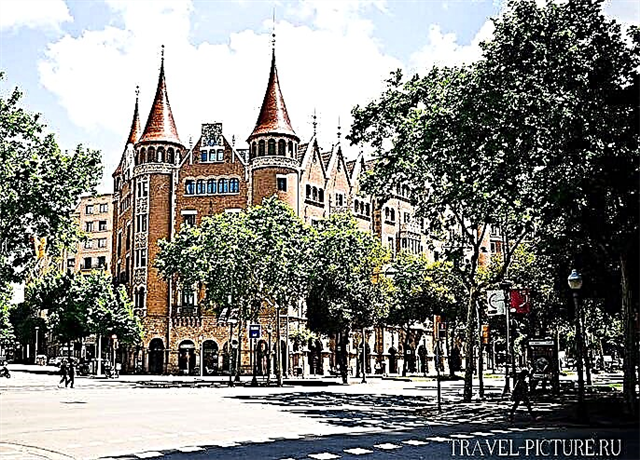
It was called the house with thorns because of the 6 towers located on the roof of the building, each tower has a spire. The structure of the building has a hexagonal shape and has the makings of the European Gothic style.
In 1975, the House of Three Sisters was declared a historical monument. Now the house with thorns is a private property, so you won't be able to get there, but you should still enjoy the look.
- You can get there by metro to Verdaguer station or Diagonal station.
Cheap flights to Spain:
- A selection of hotels and private accommodation by districts of the city, prices and where it is better to stay for a long time.

